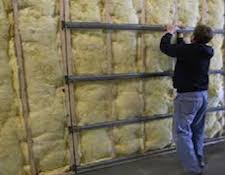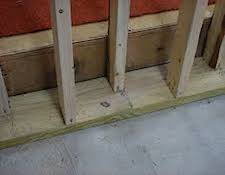It’s the time of year for saving money!
In high performance audio there are any number of well defined barometers universally used to measure our system’s sonic production. Frequency response, soundstage and imaging are but three. Many audiophiles feel that the one attribute that anchors them all together is deep, commanding, precise bass. As enjoyable as bass may be to the listener, it is probably the one thing that can annoy others in the home or the neighbors.
 Sound causes vibrational energy which causes walls, i.e. the studs, the sheetrock and even sheetrock screws to resonate. So basically, once energized, the entire wall can vibrate. Those vibrations create their own sound waves and the sonic transmission is continued. Obviously, this does not continue indefinitely, but it sure can cause your neighbor significant frustration.
Sound causes vibrational energy which causes walls, i.e. the studs, the sheetrock and even sheetrock screws to resonate. So basically, once energized, the entire wall can vibrate. Those vibrations create their own sound waves and the sonic transmission is continued. Obviously, this does not continue indefinitely, but it sure can cause your neighbor significant frustration.
Playing a system at higher audiophile volumes cause bass frequencies to travel. Lower frequencies are not readily bound by normally constructed walls. In fact, keeping bass contained in a listening room takes special planning and treatments.
Albert Einstein put it very simply. Energy cannot be destroyed. Sound is a form of energy and once released, walls do little to stop low frequency transmission. If you live in a dwelling with common walls, you have most likely had discussions with your neighbor regarding that “thump, thump, thump” they hear when your system is playing. Even single family homes placed closely together are not immune.
 One of the more popular methods to contain sound, namely low frequency sound, is by adding mass to the wall. Additional mass means more energy is required to cause vibration. It is far easier to push an empty shopping cart uphill than one loaded with bricks. So adding mass to the walls, ceiling and floor, and decoupling the sheetrock from the studs is a great first start in the reduction of vibrational energy.
One of the more popular methods to contain sound, namely low frequency sound, is by adding mass to the wall. Additional mass means more energy is required to cause vibration. It is far easier to push an empty shopping cart uphill than one loaded with bricks. So adding mass to the walls, ceiling and floor, and decoupling the sheetrock from the studs is a great first start in the reduction of vibrational energy.
First is the removal of the sheetrock on the walls and ceiling. Then, the installation of sound isolation clips, steel hat channel and two layers of sheetrock with Green Glue between the two layers. This both adds mass and also decouples the sheetrock from the studs.
 Building a second wall and floating floor is another popular method. Basically, two, two by four stud walls with an air gap between both is constructed. The studs are offset so they do not line up with each other. Sheetrock is put on the inner wall and the method described above is done to the outer wall. A second, or floating floor may be constructed, again with an air gap. What about insulation? There are a variety of insulation materials specifically designed for sound absorption that work much better than the familiar pink fiberglass type.
Building a second wall and floating floor is another popular method. Basically, two, two by four stud walls with an air gap between both is constructed. The studs are offset so they do not line up with each other. Sheetrock is put on the inner wall and the method described above is done to the outer wall. A second, or floating floor may be constructed, again with an air gap. What about insulation? There are a variety of insulation materials specifically designed for sound absorption that work much better than the familiar pink fiberglass type.
Walls, ceiling and the floor are only the start. Windows, electrical boxes and lines, plumbing, and HVAC ducting must also be considered. Because all of these are veritable interstates for sound transmission. Once any of these features become resonant, bothering your neighbor is the likely unfortunate result.
The goal in all of this is to convert the sound energy to heat so that the heat may more easily be dissipated. Conversion of vibrational energy to heat is the perfect vehicle for sound abatement.
 It is important to remember that as frequency response is reduced, the more difficult it becomes to contain vibrations. Put differently, for every octave lower in frequency sound is produced, sound isolation is halved. This explains why you get dirty looks from your neighbor on Sunday morning after your Saturday night listening session. That sub woofer you love so much is probably exactly the thing driving your neighbor nuts.
It is important to remember that as frequency response is reduced, the more difficult it becomes to contain vibrations. Put differently, for every octave lower in frequency sound is produced, sound isolation is halved. This explains why you get dirty looks from your neighbor on Sunday morning after your Saturday night listening session. That sub woofer you love so much is probably exactly the thing driving your neighbor nuts.
Sound isolation is a very complex science. Books have been written about it. Steeped in physics, isolating vibrational energy inside a specific enclosure, like a room, requires a dedicated effort. Unfortunately, such effort is usually expensive, creates a huge mess, and is not always 100% successful.
For any audiophile who has other family members and neighbors who don’t wish to be bothered, it may become necessary to consider some sort of isolation method, perhaps even headphones. Needless to say, there are other ways than described here. Some require less destruction and construction but those methods may yield lesser results.
Unfortunately, the laws of physics are in total command when it comes to sound isolation. Audiophiles have little choice but to use a containment method that works within, and takes advantage of, what physical science dictates. It is possible to adopt a method that works very well. It all depends on the room, proximity to others, budget and how aggressive a solution is used.
Of course, one could just sell the sub woofer and turn down the volume. No? I didn’t think so.





